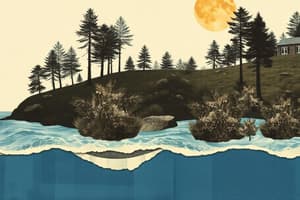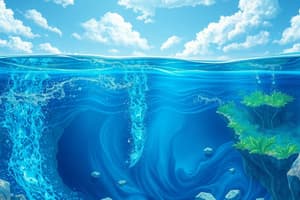Podcast
Questions and Answers
Which one of these is true about the water cycle?
Which one of these is true about the water cycle?
- Evaporation occurs from the water, plants, and sand (correct)
- Evaporation only happens from the plants
- Evaporation only happens from the sand
- Evaporation only happens from the water
Which one of these best describes the formation of tornadoes?
Which one of these best describes the formation of tornadoes?
- Tornadoes form on land (correct)
- Tornadoes form from cold air sinking
- Tornadoes form over large bodies of warm water
- Tornadoes form from warm air rising
Which one of these is true about climate?
Which one of these is true about climate?
- Climate refers to the current weather conditions
- Climate refers to the weather conditions of a small area
- Climate refers to the condition of a region over time (correct)
- Climate refers to the condition of a region at a particular time
Which one of these is true about the impact of the sun on Earth's weather?
Which one of these is true about the impact of the sun on Earth's weather?
Which one of these is true about sand and ocean water?
Which one of these is true about sand and ocean water?
Which type of heat transfer occurs when objects must touch the heat source?
Which type of heat transfer occurs when objects must touch the heat source?
What causes wind?
What causes wind?
How does radiation from the sun affect weather conditions?
How does radiation from the sun affect weather conditions?
What do the red and blue circles represent?
What do the red and blue circles represent?
Flashcards are hidden until you start studying
Study Notes
Weather and Climate
- The water cycle involves the continuous movement of water on, above, and below the surface of the Earth.
Tornado Formation
- Tornadoes form when a combination of atmospheric conditions come together, including warm, moist air near the surface, cooler air above, and wind shear.
Climate
- Climate refers to the long-term average atmospheric conditions in a particular region.
Sun's Impact on Earth's Weather
- The sun's energy heats the Earth's surface, atmosphere, and oceans, influencing weather patterns and conditions.
Sand and Ocean Water
- Sand and ocean water interact through processes such as coastal erosion and deposition.
Heat Transfer
- Conduction is the type of heat transfer that occurs when objects must touch the heat source.
Wind
- Wind is caused by the uneven heating of the Earth's surface by the sun, resulting in differences in air pressure.
Radiation and Weather
- Radiation from the sun affects weather conditions by heating the Earth's surface, atmosphere, and oceans, influencing temperature and atmospheric circulation patterns.
Red and Blue Circles
- The red and blue circles likely represent high and low-pressure systems, respectively, which are key factors in shaping weather patterns.
Studying That Suits You
Use AI to generate personalized quizzes and flashcards to suit your learning preferences.




